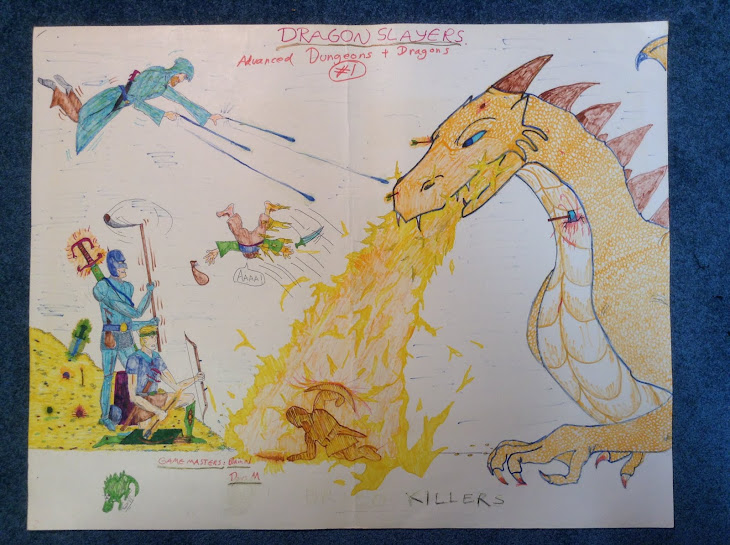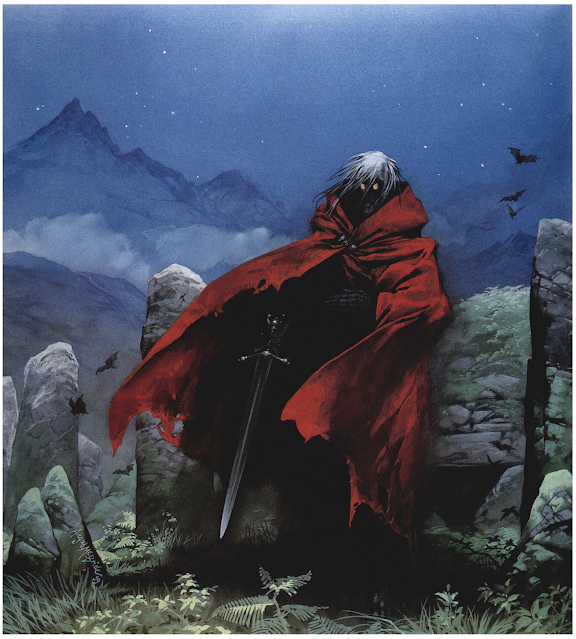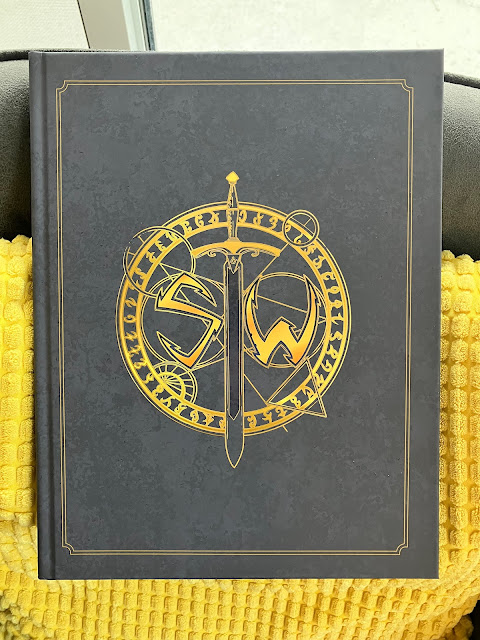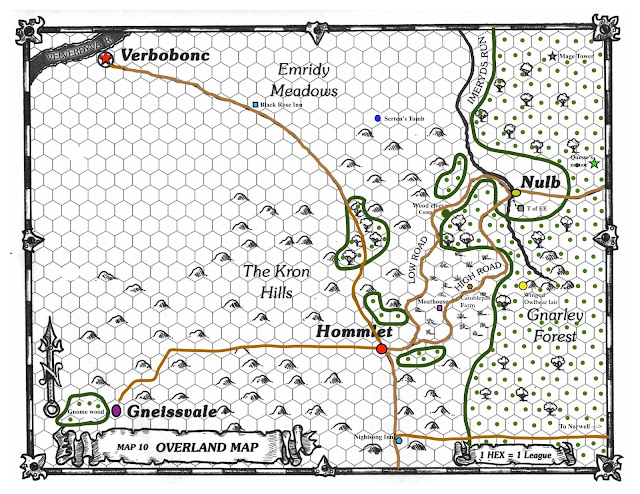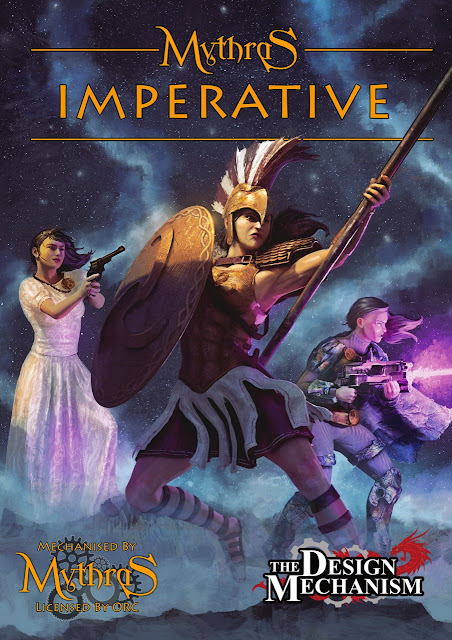The great southern island of Urdor is home to many peoples: dwarves, elves, giants, halflings, men, orcs, trolls, and dragonspawn. Below are brief descriptions of a few of the core ‘civilized’ realms – those located in the central southern part of the island – and the peoples who dwell therein. (Notes on other realms and peoples will be provided in a future post.)
(Credit notes: The text below draws upon the original descriptions by Terry Amthor, the author of The Court of Ardor. I’ve revised the descriptions of the realms, sometimes quite heavily [especially Dûshera and Mûmakan], in order to render them compatible with Ukrasia, as well as making them more to my taste overall. The top beautiful map is by Peter Fenlon. My map, which covers the entire island of Urdor, is at the bottom.)

DÛSHERA (Halflings, Dwarves, Tantûraki [high men])
A sparsely settled land, Dûshera once was part of a noble human realm that also included the area now known as Geshaan. That realm achieved a high level of civilization late during the Era of the Elves, but eventually was destroyed by the Night Elves over 3700 years ago. Dark magic caused part of the realm to sink – forming the great swamp of Geshaan – while the other mortal inhabitants were slain. For millennia afterwards, the region was considered cursed and generally avoided by civilized peoples.
When the Arsilonian realm of Rylindar established the colony of Tantûrak around 1600 of the First Age of Humanity (roughly 1950 years ago), many Halflings moved there as well. Over the years, though, the small people decided that they preferred the relative freedom of the rolling plains and open hills of Dûshera, and hence relocated there, eventually establishing a semi-autonomous realm. When Rylindar fell under the tyrannical rule of the Autarch, Tantûrak became increasingly oppressive domestically and antagonistic in its relations with other realms. However, the Halflings of Dûshera maintained their (conditional) freedom by agreeing to supply Tantûrak with one-third of their agricultural product annually, and permitting the free travel of Tantûraki troops through their lands. Seeing the little people as no threat, and judging Dûshera to be of no great strategic value, Tantûrak agreed to these terms. For the past 1400 years or so, this relationship between the two realms has persisted without disruption.
The Dûsheran Halflings are hardworking folk who rarely travel beyond their lands. They revere the deity Fiona above all others. Although technically part of the Solar Church, the followers of Fiona throughout Dûshera are only loosely associated with it, governing themselves and sending annual tithes as necessary. This is tolerated grudgingly by the Church hierarchs in Tantûrak. The few Halflings who wander to other lands often revere the mysterious “Dog Lord.”
In recent decades, some Dwarves from the Skyclaw Mountains (which run along the northern coast of the great isle) have established a few tin mines in the hills west of Geshaan. They maintain friendly, if somewhat aloof, relations with the Halflings. These Dwarves travel far more than the Halflings, often taking their goods to their home realm, the Halls of Pale Steel, as well as the human cities of Korlan, Tanith, and Sarûl, in addition to smaller towns throughout Urdor. The Halflings are eager to purchase the goods that these Dwarven traders bring back with them, and hence have established a number of inns and taverns catering to Dwarfish tastes.
Unlike other kin, the Dwarves worship no deities. Instead, they believe that they are reincarnated until they achieve mastery of all the “eternal virtues.” Once this state is attained, they hold that their souls will leave the cycle of life and death and merge with the eternal “Form” of the “Good.” Unfortunately, Dwarf philosophers have yet to agree on the exact composition of these virtues.
There are a few minor settlements of Tantûraki in Dûshera as well. For the most part, these are individuals and groups who chafe at the oppressive reign of their king and his malevolent advisor, “The Magician.” For obvious reasons, they try to keep low profiles and go to great pains to assure the Halflings of their benign intentions.
Kins: Halflings (most common), Dwarves, High Men (Tantûraki).
Cultures: Halflings: Pastoral, Hill. Dwarves: Deep, Hill. Tantûraki: Noble, Weald.
HATHOR (Hathorians [men])
Hathor is a centralized kingdom, traditionally ruled by a strong monarch out of the capital city of Tanith. As is obvious to any scholar, the Hathorians are not native to their land. Blond and blue (or grey) eyed, with naturally fair skin (though tanned by the sun), they migrated to their present land almost two eons ago, after the conquest of the Vilkhorith islands in the far north by the Dragon King Sulthrax. Indeed, “Hathor” was the name of the great prophet who led his tribe to this land.
Hathorians are easy-going of temperament, but often wild and adventurous. Their society is built around recreation, including attendance at and participation in athletic games of all kinds, singly or in teams, in land or in the water, by men or women. Although these sports are always played without intention of injury, the very nature of most of them make it almost inevitable that someone will get hurt every time. Fortunately, however, Hathorian have an aptitude for the healing arts.
The games, although just one facet of Hathorian society, are an excellent example of their rather hedonistic attitude towards life. Above any other reason, Hathorians like to do things because they might be ‘fun.’ However, their view of ‘fun’ bears little similarity to that of most other cultures. Hathor accounts for the largest percentage of Taaliraan wine and spirit exports; Hathorians also use a large percentage of their grain imports for the making of beer. Surprisingly, despite – or perhaps because of – their hedonistic lifestyle, Hathorians are quite religious. They revere most of the Glade Court.
Hathorians are among the vainest of peoples, working ever hard at making the most of their appearance, which nearly rivals that of the Elven-kind, albeit perhaps in a more ‘rough’ way. No other culture uses so many oils and balms to make their skin look ‘natural.’ Of course, it must be acknowledged that because of their naturally fair skin, the Hathorians require some defence against the intense sun of the tropics. Both genders wear their hair quite short to keep cool. Hathorian males are generally clean-shaven. Skilled spell-casters, though, make a point of growing beards (the longer the beard, the higher their position within the Hathorian wizard or animist hierarchy). Female spell-casters grow their hair in long braids (with length, again, an indicator of rank).
The Hathorians delight in simple jewelry, usually gold, in the form of necklaces and wrist and ankle chains, and earrings (for both sexes, although men tend to wear but one earring, bracelet, and chain, while women prefer multiples). Both sexes have an aversion to finger rings, maintaining that they interfere with various activities. The men clothe themselves in loose pants or shorts of cotton, or silk for more formal occasions, dyed bright colours. The women wear either shorts and a laced top, or for less rigorous activities, short, draped toga-like garments of finely woven diaphanous cloth.
Hathor is close with Koronande, and friendly with both Tuktan and Taaliraan. They suffer raids regularly from roaming hordes of orcs from Mûmakan. Relations with Tantûrak are often tense, but the distance between the realms and ongoing trade has prevented outright war between the two kingdoms for the past thousand years.
Kin: Men (Hathorian).
Cultures: City, Noble, Pastoral, Weald.
KORONANDE (Kirani [men], Green Elves [dusk elves])
The government of Koronande is a republic. Its political system was established over 2500 years ago by Lemka the Lawgiver, and has remained intact, with few modifications, since that time. Koronande is also unusual in that it is a realm populated by both Men (Kirini) and Elves (Green Elves), although the former make up almost ninety percent of the overall population. As might be expected, the Elves inhabit the more rural, forested areas of Koronande, constructing beautiful and elaborate homes in the branches of huge trees, which often grow to heights exceeding 70 metres (200 feet), the greatest example of which is Tauronde, the city which presides over the district of the same name, north and west of Korlan. It is almost entirely Elven in population, and its governor and senate representatives are Elves. Tauronde the city is in fact a cluster of Luraks, lord trees of the jungle, into the branches of which have been built elaborate homes and shops, inns, and halls, all well over forty metres above the jungle floor. The Kirani and Elves share a mutual respect and admiration. Indeed, there have been rare marriages between the two races.
The capital of Koronande is Korlan, on the mouth of the Koros river. The realm is divided into six districts, each having its own main town and governor. The Senate consists of thirteen members, two from each of the districts, and one appointed by the military, who meet monthly for three days to decide matters of concern to the realm as a whole. The Republic has a strong navy, the only one in the region which can contest that of Tantûrak. They are the traders of Urdor, rivalled only by the Dwarves, and so Korlan is a centre of commerce.
The Kirani are native to the land. They have very dark skin colour and black, wiry hair. Lean and tall (as tall as the Tantûraki, but far more svelte), their features are angular, almost ‘elvish’ in nature. Kirani males tend to be clean shaven. Most wear their hair relatively short. In the way of clothing, the Kirani prefer flowing, diaphanous garments, dyed in a variety of pastel colours, and draped loosely about the body. These they wear when they can get away with it, but of course such are not suitable for everyday work, for which they don short kilts in the case of men, and the women tend to wear short, belted dresses. Both sexes wear jewelry, although they prefer items of leather worn about the head and wrists, with bright bird feathers dangling, rather than the gold and gem-beset decorations most other peoples prefer.
The Kirani are basically vegetarians, cultivating the many varieties of fruit bearing vines and trees which flourish in the area. They do occasionally dine on fowl: the large avian inhabitants of the jungle are broiled and considered a delicacy. They are reasonably religious, and generally follow the deities of the Glade Court.
Koronande has strong ties with Hathor. Relations with Tuktan are also quite close, as the Kirani people populate both realms. However, the citizens of Koronande tend to look down upon their more ‘primitive’ cousins (much to the irritation of the Tuktani). Koronande – thanks in large part to its Elvish population – is very friendly with Taaliraan. Relations with Tantûrak have always been poor, and the two lands are frequently at war. Like Hathor, Koronande suffers from regular raids from the savage orcish tribes of Mûmakan.
Kins: Men (Kirani), Dusk Elves (Green Elves), Half-Elves (very rare, same Cultures as Kirani).
Cultures: Kirani: City, Pastoral, Seafaring, Weald. Elves: City (Tauronde only), Fey, Weald.
TAALIRAAN (Green Elves [dusk elves], Blue Elves [silver elves])
A realm of united Green and Blue Elves, Taaliraan is one of only a few politically organized Elvish lands throughout the great southern island of Urdor. It has been ruled for over two millennia by Prince Eldanar, a Blue Elf lord of considerable power. What was once the northern part of the realm was ruled by the Green Elvish queen, Blàithnaid, in alliance with Prince Eldanar. Her people suffered great loss in their war against Tantûrak an eon ago, however, and the boundaries of Taaliraan retracted afterwards. The queen’s fate is unknown.
Prince Eldanar rules his realm with a light touch, preferring to allow most Taaliraani communities a great measure of self-government. He reigns from the land’s only city (really a large town), Tilvirin, which is a seaport overlooking one of the realm’s southern bays. The Blue Elves of Tilvirin love the sea, and many enjoy going on long journeys for both leisure and trade. The Green Elves primarily live within the western woodlands, whereas the Blue Elves favour the coastal lands and the vineyards of the central valleys. The wines of Taaliraan are famous throughout Ukrasia.
Taaliraan is a largely self-contained country, traditionally remaining aloof from most regional politics. During the Great War ten centuries ago, though, it did ally with Koronande and Hathor against the Rylindar Imperium. The Elves fought bravely alongside the Kirani and Hathorians against the Imperial Tantûraki forces. The War cost the Taaliraani greatly, though, and the boundaries of the realm subsequently retreated to the southwestern portion of the peninsula. The northern lands, which border Tantûrak and Koronande, are now a wild, ungoverned region, although some bands of Green Elves still wander there, and outcasts from other lands (Kirani, Hathorians, Tantûraki, and even orcs) have established scattered freeholds. It is thought that the place is cursed because of all the deaths it witnessed an eon ago, and rumours of undead and other monsters wandering at night keep most civilized people away. Yet it is believed that Tantûrak now covets the land and may soon seek to take it over.
The Elves of Taaliraan wear less clothing than their northerly counterparts, preferring simple belted tunics in white, grey, green, or brown. Jewelry is usually minimal, but invariably high-quality and delicate. As with the other races of Urdor, the Elves of the area wear year-round tans, yet only these immortals maintain wrinkle-free skin with the passage of time, due to the regenerative nature of their bodies.
Kins: Silver Elves (Blue Elves), Dusk Elves (Green Elves).
Cultures: Blue Elves: City (Tilvirin only), Noble, Pastoral, Seafaring, Fey. Green Elves: Fey, Weald.
TANTÛRAK (Tantûraki [high men], Orcs)
A colony of Rylindar founded around 1600 of the First Age of Humanity, Tantûrak is one of the southernmost of the Arsilonian settlements in Ukrasia. Despite their distance from other Arsilonian realms, the Tantûraki maintain the traditions of their ancestors, and were loyal to the Rylindar Imperium until the fall of the Autarch a thousand years ago.
Dominating the northwestern portion of Urdor, Tantûrak is flanked by rolling hills and mountains to the north. The western portion of the country is settled primarily by orcs – farmers, miners, and soldiers – under the control of Tantûraki overlords. The capital city of Tantûrak is Sarûl, which lies on the Uvar river. Based here is the formidable navy of Tantûrak. To the east lies Dûshera, which the Tantûraki regard as a vassal realm.
When the colony was established almost two thousand years ago, it was overseen by a governor who answered to the ruling powers in Rylindar, first the Republican Supreme Council, and then (after 2097 of the previous Age) the Autarch and his minions. This system functioned more or less smoothly for almost a thousand years, until the defeat of the Autarch at the end of the First Age of Humanity. Tantûrak suffered quite badly in the southern front of the Great War at the end of that Age, its military crushed decisively by the allied forces of Taaliraan, Koronande, and Hathor. Only those realms’ relative weakness at the time (as they had been drained after decades of conflict) prevented the full destruction of Tantûrak. In the early years of the Second Age of Humanity, with all ties to the former Rylindar Imperium severed, the son of the last governor declared himself the first king of Tantûrak, King Vanak the First. Over the ensuing centuries, Tantûrak gradually rebuilt its military and reconquered its western lands.
Around 700 of the Second Age, the “Magician” arrived in Sarûl. The date is uncertain, as he came with little fanfare and rose quietly, albeit swiftly, through the ranks of the king’s advisors. Soon the Magician was the chief advisor to King Taraxil the III, and advised him to adopt, as a long-term goal, the conquest of all Urdor. Relations with other realms, especially Koronande and Taaliraan, subsequently deteriorated. Indeed, Koronande and Tantûrak have fought several wars over the past three centuries. And while five kings have come and gone since Taraxil III, the Magician remains.
Like the Hathorians, the Tantûraki originally are from a more northerly land. As the “High Men” name suggests, the Tantûraki are among the tallest of the mortal peoples, rivalled in the region only by the Kirani. Naturally pale, most Tantûraki acquire a deep “bronze” complexion from exposure to the tropical sun. The most exotic looking of the mannish peoples, they typically have either silver hair (ranging from a dark ‘iron’ shade to a bright ‘platinum,’ almost golden, hue) or (less often) white hair. Eye colours include amber, green, and violet (with the latter most common in those with white hair). Men normally are clean-shaven, and both sexes grow their hair past their ears (women somewhat longer, past their shoulders). Physically powerful, the Tantûraki enjoy the long lifespans of all Arsilonians, living normally for two centuries (barring accident, disease, or violence, the latter quite common). Their physical and mental robustness, combined with their longevity, cause many Tantûraki to look down upon the other mannish peoples of the region, and bitterly envy the Elves.
The Solar Church is the primary religious authority within the realm. It enthusiastically seeks out and either “converts” or slays heretics, apostates, and adherents of other faiths.
Kin: High Man (Tantûraki); Orcs.
Cultures: High Man: City, Noble, Seafaring, Weald. Orcs: City, Hill, Pastoral, Weald.
TUKTAN (Kirani [men])
Lying to the east of the great swamp Geshaan, Tuktan encompasses rainforests, hills, and plains. The realm is made up of an interconnected web of Kirani villages, loosely knitted together by an informal central government consisting of a council of seventeen ‘Jilhani’ (village leaders). The Jilhan council meets semi-annually, or if a threat to the realm as a whole warrants it. Otherwise, each Jilhan rules his or her town as he or she sees fit. All engage in a lively trade amongst themselves and adjacent Koronande.
It is within the Tuktan’s great oval rainforest alone that the Jeedic Teak trees flourish, and their wood is prized throughout Urdor. Not surprisingly, Tuktan wood craftsmen are very skilled, and their furniture and bows are highly sought after. Tuktan composite bows can bring a price many times the average, and are said to be superior to any other, save the most powerful magical Elvish bows.
The Tuktani are more devout than their kinsfolk in Koronande, and the shamans (animists) who revere the Glade Court enjoy authority and status second only to the Jilhani.
Of late, Tuktan has had increasing problems with the orcish tribes of the Mûmakan. Envying the fine homes and rich lands of the Tuktani, the orcs are becoming ever more antagonistic, raiding the bordering villages with increasing frequency.
Kins: Men (Kirani).
Cultures: Pastoral, Hill, Weald.
MÛMAKAN (Orcs, Half-orcs, Men [various])
Mûmakan is a diverse land of plains, hills, rainforests, and lakes. It is inhabited by semi-nomadic orcish tribes, as well as some bands of men (typically outcasts from other lands and their descendants) and even trolls. The people are generally simple and barbaric. Most tribes sustain themselves by hunting, grazing livestock, and even engaging in agriculture. However, they satisfy their other needs not so much by trade, but rather by regularly raiding the adjacent lands of Tuktan, Koronande, and Hathor.
There has been no central government in Mûmakan for many centuries. Amongst the orcs, the primary social organization is the tribe; these are extremely large extended families, ruled by the oldest living females. The men who live in the land are typically organized into bands led by petty warlords; they sustain themselves by engaging in hunting and raiding.
All orcish tribes meet annually at the religious centre of the land – Amaru, a holy place where the tribes interact, trade, and marriages are arranged. Above all, they pray to their god Amaav, who it is said speaks to them through their high priest. The war priests among the tribes claim that Amaav dwells within the realm of Flux, and rewards greatly those who die in battle.
The Mûmakani make extensive use of a huge animal both as beast of burden and as a fierce war machine: the ‘Mûmak’ – also called the great elephant.
Some rare Mûmakani – orcs, half-orcs, and men – weary of the primitive ways of their homeland and seek better lives in more civilized realms, often as mercenaries. While there is much prejudice against them in other lands, few can deny their battle skills, and so employment is often available.
Kins: Orcs, Half-orcs, Men (any, often mixed).
Cultures: Hills, Plains (ride elephants instead of horses), Woad, Marauding.
ARDINAAK
Not a true realm, Ardinaak nonetheless is worthy of mention. Originally part of Tantûrak, and indeed an important naval base during the colony’s youth, Ardinaak was struck by a sudden and mysterious plague in 1908 of the First Age of Humanity. Within days everyone was dead.
Histories tell that the witnesses who fled the island after the first signs of the plague had seen a brilliant flash of light come from the rocky isle in the centre of the bay (which had never been landed upon because of its sheer sides and the treacherous rocks all about it) one night. Those who were unfortunate enough to be looking in that general direction were blinded permanently. Then, within hours people began to grow ill, and their skin became mottled. Even those who had escaped the isle immediately after the flash soon died on the mainland, although they did not transmit the disease to others.
No one has returned to Ardinaak since, according to the records. It has been speculated by some sages that what struck the isle was not a disease, but an immensely powerful curse of some sort. At any rate, the land is associated with death, and its name is not spoken.

Above is the map I drew and coloured (by hand) of the island Urdor. I will be adding important locations and political borders (using Preview) later. In a future post I'll provide some further notes about the island.
